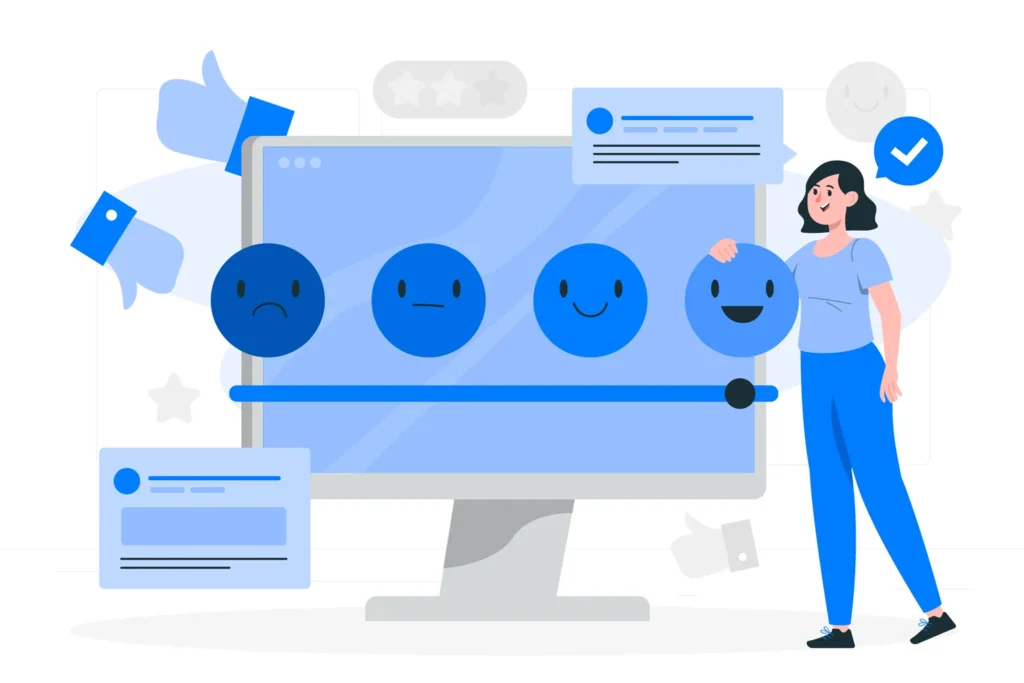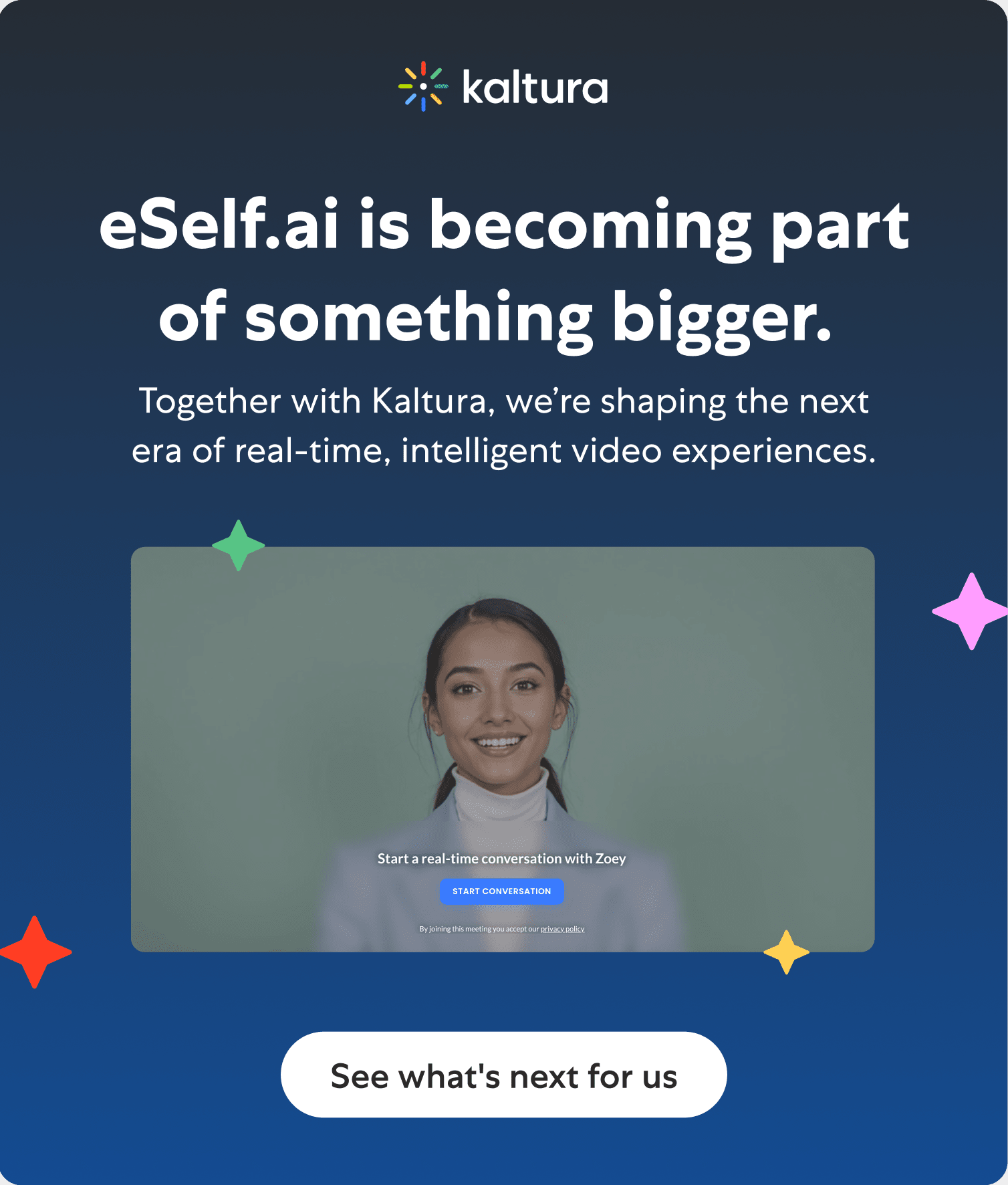Customer experience (CX) is the sum of every interaction a customer has with your brand — from the first website visit to post-purchase support. It’s not just about delivering products or services; it’s about how customers feel when engaging with your business.
A positive customer experience builds loyalty, fuels word-of-mouth referrals, and drives revenue growth. In contrast, even one negative experience can turn a customer away forever. Understanding how to improve your customer experience isn’t optional — it’s essential to maintaining a competitive edge in today’s market.
Let’s explore proven strategies to improve customer experience that drive real results.
Why Bad Customer Experience Hurts Your Business
Poor CX damages trust, drives customers to competitors, and leads to negative reviews that hurt brand reputation.
Businesses risk high churn rates, lower customer lifetime value, and declining revenues when they neglect customer experience.
This gap between what customers expect and what they actually experience is a widespread problem across industries — as the following chart illustrates:
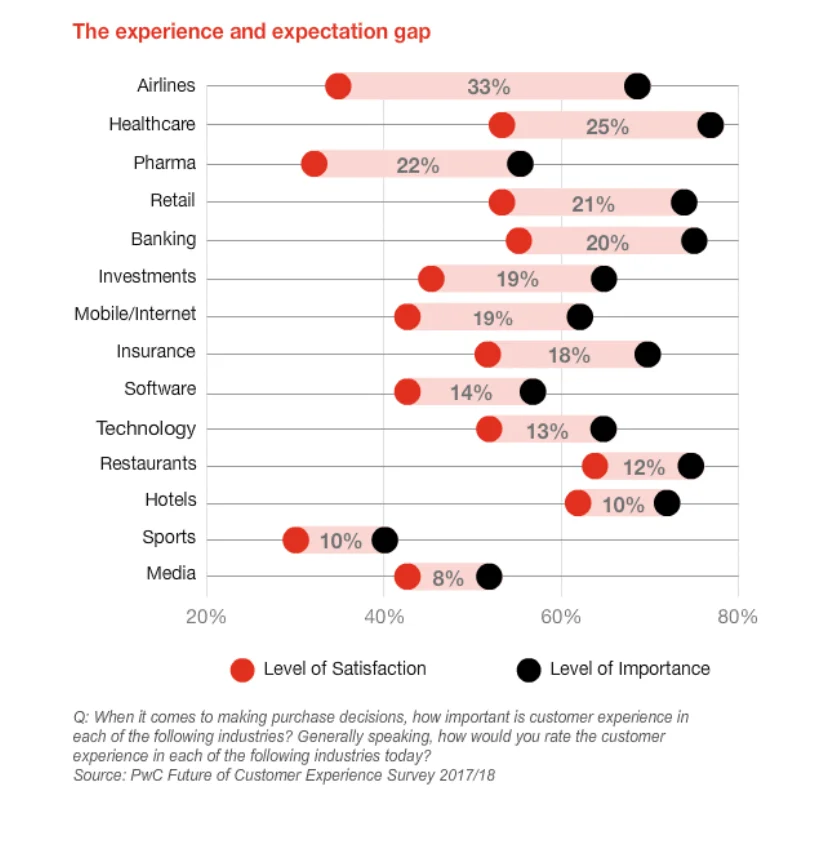
Studies show that 32% of customers would stop doing business with a brand they love after just one bad experience.
Today’s business environment is especially unforgiving as AI is transforming customer engagement and setting higher expectations for personalization, speed, and service quality.
Why Do Customers Leave?
Several key frustrations push customers away:
- Poor customer service interactions (40%)
- Having to repeat themselves to multiple agents (30%)
- Long wait times for support (28%)
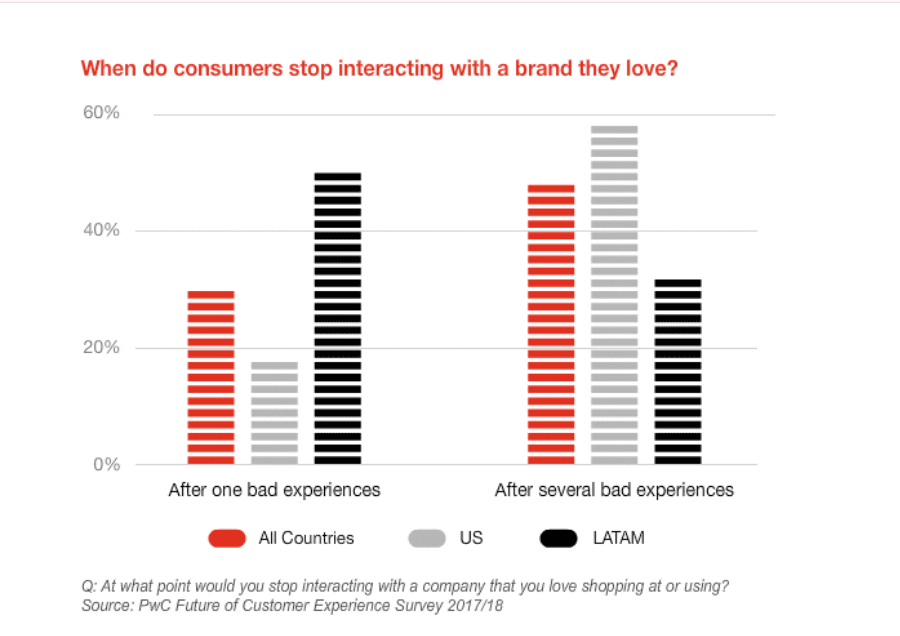
Today’s customers expect effortless, seamless communication across all touchpoints. Omnichannel communication — offering consistent service across web, mobile, chat, social media, and phone — has become essential for meeting modern customer expectations.
Technology + Human Touch = The Winning Formula
While technology helps streamline support and improve responsiveness, it’s not enough by itself.
Building emotional connections remains critical: 86% of customers say they would stay loyal to a brand if they felt a positive emotional bond with its representatives.
The businesses that succeed combine efficient technology with genuine human empathy, creating customer experiences that are both convenient and deeply personal.
12 Proven Methods on How to Improve Customer Experience
Before we dive into specific strategies, it’s important to understand what makes a great customer experience – what customers actually value most in their experiences. The chart below highlights the CX elements that customers are willing to pay more for:

1. Understand Your Customers Deeply (Customer Research)
Before you can meet customer needs, you must first understand them. The first step to improve customer experience is knowing who your customers really are.
Conduct surveys, interviews, focus groups, and analyze behavioral data to build detailed customer personas. Knowing their pain points, desires, and behaviors helps tailor your products, services, and communication to resonate on a personal level.
Example: Spotify continuously gathers user listening data to recommend hyper-personalized playlists, keeping engagement high.
2. Map and Optimize Every Step of the Customer Journey
A customer journey map visualizes all touchpoints a customer has with your brand.
By mapping the journey, you can identify friction points, bottlenecks, or confusing steps — and optimize them to create a smoother customer experience.
Example: Disney meticulously maps every guest interaction, from booking to park exit, ensuring a seamless magical experience.
3. Personalize Interactions
Customers expect personalization — not generic messages.
Use customer data (their names, remember past purchases, etc.) to offer personalized product recommendations, emails, and support. Tailor communications based on behavior, preferences, and past interactions. Personalization is one of key ideas to improve customer experience and drive loyalty.
Example: Amazon’s recommendation engine drives 35% of its revenue through personalized product suggestions.
4. Empower and Train Your Employees
Frontline employees are the face of your brand. Empowered employees can solve issues faster, creating happier customers.
Equip them with the tools, training, and authority to resolve customer issues independently and deliver memorable experiences.
Example: Ritz-Carlton empowers employees to spend up to $2,000 to resolve customer issues on the spot — no manager approval needed.
5. Speed Matters — Reduce Customer Effort
Fast, easy interactions are critical – customers value their time.
Streamline processes, eliminate unnecessary steps, simplify checkouts, provide quick responses, and offer self-service options to minimize customer effort. Quick, hassle-free service reduces churn and builds loyalty.
Example: Zappos offers hassle-free returns and fast customer service, making shopping effortless and risk-free.
6. Deliver a Seamless Customer Experience Across Every Channel
Today’s customers may interact with your brand on social media, your website, or in-store — and they expect a consistent, smooth experience across all touchpoints
A disconnected experience confuses and frustrates customers. Ensure your brand voice, quality of service, and available information stay consistent, no matter how a customer interacts with you.
Example: Starbucks connects app, loyalty program, and in-store purchases into one unified experience.
7. Proactively Solve Problems
The best service is the one customers don’t have to ask for. Don’t wait for customers to complain — identify potential issues and fix them before they escalate.
Use data to anticipate customer needs or spot issues early. Reach out with solutions before customers even realize there’s a problem. Proactive service shows you care.
Example: Delta Airlines often rebooks passengers automatically when flights are delayed or canceled.
8. Leverage Technology Smartly
Technology should make the experience better — not more complicated.
Investing in smart CRM tools, AI support, and automated workflows is a modern answer to how to enhance customer experience efficiently.
Example: Sephora uses AI-powered chatbots for makeup consultations, helping customers find products suited to their preferences.
Beyond these essential strategies, forward-thinking businesses are adopting innovative technologies to push customer experience even further.
Innovative Ideas to Improve Customer Experience
Innovation is key to staying ahead. Some ideas include:
- AI Customer Agents: AI agents can provide 24/7 support, instantly answering questions and solving problems without human intervention.
- Digital Twins for CX: Create virtual models of customers to predict behaviors, personalize experiences, and optimize services.
- Predictive Analytics: Anticipate what customers will need next based on data patterns.
- Virtual Try-Ons: In retail and fashion, augmented reality apps allow customers to “try” products virtually.
- Digital humans can enhance CX by offering emotionally intelligent, lifelike interactions
Why businesses need it: These innovations make experiences faster, easier, and more exciting — while giving brands a major competitive edge. Customers increasingly expect tech-driven, ultra-personalized service, and businesses that deliver it will win their loyalty.
9. Get Real Feedback with Open-Ended Questions
Don’t just ask for ratings — ask for stories. Instead of simple yes/no surveys, ask open-ended questions like “What could we have done better?” or “How did you feel during your experience?”
Open-ended feedback reveals true customer sentiment, pain points, and hidden opportunities that closed questions miss.
Open-ended feedback provides richer insights on how and where to improve your services to get better customer experience.
Example: Airbnb invites guests to share open-text reviews, helping the platform refine listings and experiences.
10. Focus on Emotional Connection
Winning customers’ hearts creates loyalty that transactions alone never will. Building an emotional bond is essential for companies asking how to create a great customer experience that truly resonates.
Train your team to treat customers with empathy, gratitude, and humanity at every interaction. Emotions drive decisions. A customer who feels understood and valued is much more likely to return.
Example: Chewy sends handwritten sympathy cards to pet owners who have lost their pets, creating deep emotional bonds.
11. Set a New Standard for Customer Service Excellence
Respond quickly, be empathetic, and go above and beyond expectations. Don’t just aim to meet expectations — aim to exceed them. Surprise customers with unexpected perks, faster delivery, or personalized thank-yous.
Excellence in service should become a brand signature that customers associate with trust and reliability. Going beyond expectations is a key element when thinking about how improve customer experience at every interaction.
Example: Nordstrom is famous for legendary service stories, like accepting a return for a product they don’t even sell.
12. Build a Strong Voice of the Customer Program
Don’t just collect feedback — organize it into structured programs.
VoC programs turn customer insights into actions that improve products, processes, and policies systematically. Create structured ways to collect, analyze, and act on customer feedback continuously — through surveys, interviews, social media monitoring, and more.
Listening, analyzing, and acting on customer feedback systematically helps companies improve customer experience strategy over time.
Example: Adobe uses real-time VoC dashboards to prioritize fixes and product improvements based on customer feedback.
Use Cases of Improving Customer Experience
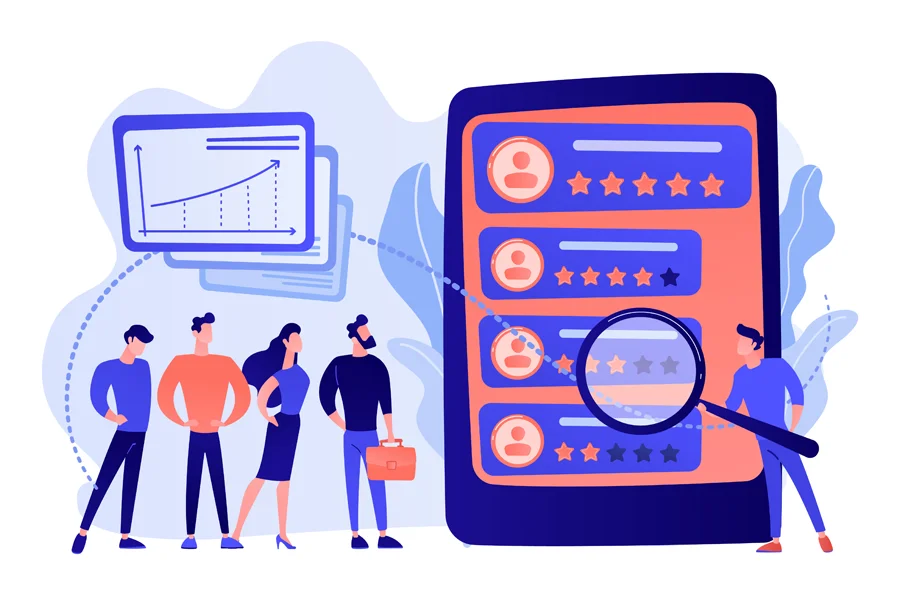
Customer experience (CX) strategies can look very different across industries — but the goal is always the same: make interactions faster, easier, more personal, and more delightful. Here are practical examples from different sectors:
Improving Customer Experience in Retail: Personalized Shopping Journeys
Use Case:
Retailers can use data analytics to personalize recommendations, offers, and promotions based on customer preferences and past purchases. AI tools are reshaping the sector, and AI in retail is setting new standards for personalized customer experiences.
Real-World Example of Improving CX in Retail:
Sephora uses a combination of in-store technology and online profiles to offer personalized product suggestions, loyalty rewards, and even virtual makeup try-ons through its app — creating a seamless beauty shopping experience across digital and physical channels.
Improving Customer Experience in Hospitality: Anticipating Guest Needs
Use Case: Hotels can improve customer experience by proactively anticipating guest needs before arrival and during their stay, using CRM systems and guest history data. AI in hospitality plays a vital role by helping hotels deliver truly customized services.
Real-World Example of Improving CX in Hospitality: Ritz-Carlton customizes guest experiences based on previous visits — remembering favorite drinks, pillow types, and even room preferences — making every stay feel personalized and luxurious.
Improving Customer Experience in Banking & Financial Services: Streamlining Support
Use Case:
Banks can use AI-driven chatbots and digital self-service portals to solve customer issues faster while maintaining human support for complex needs.
Real-World Example of Improving CX in Banking & Financial Services:
Bank of America introduced Erica, an AI virtual financial assistant, helping customers with tasks like checking balances, scheduling payments, and even offering financial advice — reducing support wait times and increasing customer satisfaction.
Improving Customer Experience in Healthcare: Reducing Wait Times and Improving Communication
Use Case: Healthcare providers can enhance customer experience by offering online appointment booking, telemedicine services, and patient portals for easier communication and follow-ups.
Real-World Example of Improving CX in Healthcare: Kaiser Permanente offers robust online services, including virtual consultations and mobile health apps, enabling patients to book appointments, get test results, and communicate with doctors efficiently — reducing friction in a traditionally slow-moving industry.
Improving Customer Experience in Telecommunications: Proactive Issue Resolution
Use Case: Telecom companies can monitor network health and proactively inform customers about outages or service disruptions, offering solutions or credits before customers even complain.
Real-World Example of Improving CX in Telecommunications: T-Mobile proactively contacts customers affected by service disruptions, often offering billing credits or expedited solutions — a strategy that strengthens trust and loyalty.
Improving Customer Experience in E-commerce: Hassle-Free Returns and Exchanges
Use Case: Online stores can improve CX by simplifying the returns process, offering clear policies, prepaid return labels, and instant refunds. AI in e-commerce supports this by powering smarter product recommendations, dynamic customer support, and faster service automation.
Real-World Example of Improving CX in E-commerce: Zappos built a reputation for outstanding service by offering 365-day returns with free shipping both ways, removing customer hesitation from online shoe shopping.
Improving Customer Experience in Transportation & Airlines: Real-Time Updates and Rebooking
Airlines can leverage mobile apps to keep travelers informed about gate changes, flight delays, and boarding information — and even rebook flights automatically when disruptions occur.
Real-World Example of Improving CX in Transportation & Airlines: Delta Airlines provides real-time push notifications about flight status through its app and even offers automatic rebooking for delayed or canceled flights — turning stressful travel moments into manageable ones.
Improving Customer Experience in Technology & SaaS: Onboarding and Self-Service
Tech companies can focus on seamless onboarding processes, interactive tutorials, and robust self-help resources to reduce friction and increase adoption.
Real-World Example of Improving CX in Technology & SaaS: Slack offers interactive onboarding workflows, tutorial pop-ups, and a detailed help center that guides users through platform setup — ensuring faster time-to-value for new users.
Across industries, the best customer experience improvements share common threads: personalization, proactive service, speed, transparency, and emotional connection. Businesses that invest in making experiences smoother and more memorable don’t just satisfy customers — they turn them into loyal advocates.
Turn Great CX Into Your Competitive Advantage
In a crowded market, what makes a great customer experience often becomes the ultimate differentiator.
Investing in strategies to improve customer experience builds loyalty and growth that competitors can’t easily replicate.
To stay ahead, it’s essential to focus on putting the customer at the center of every business decision and innovation effort.
Ready to take your customer experience to the next level? eSelf.ai empowers businesses to create smarter, more personalized experiences using AI-driven digital twins, AI video agents, and AI video chatbots.
Let’s build amazing customer experiences together with eSelf.ai!
FAQs About How to Improve Customer Experience
What are the best ways to improve customer experience?
Understand customers deeply, personalize interactions, empower employees, speed up service, and proactively solve issues.
How do you measure customer experience effectively?
Use metrics like Net Promoter Score (NPS), Customer Satisfaction Score (CSAT), Customer Effort Score (CES), and analyze open-text feedback.
What is the difference between customer experience and customer service?
Customer service is one part of the overall customer experience — CX includes every touchpoint across the customer journey.
Can AI improve customer experience?
Yes. AI powers personalized recommendations, 24/7 support, predictive services, and real-time problem-solving.
How do small businesses improve customer experience on a budget?
Focus on personalization, fast and empathetic service, and use affordable tools like CRM platforms and chatbots.
What are key pillars of a great customer experience?
Personalization, consistency, speed, proactive support, emotional connection, and feedback-driven improvement.
What technology enhances customer experience?
CRM systems, AI chatbots, customer journey analytics, digital twins, virtual assistants, and mobile apps.
How to boost customer satisfaction?
Listen actively, personalize service, reduce friction, act on feedback, and create emotional connections.
How do you fix poor customer experience?
Identify root causes using feedback, retrain employees, redesign broken journeys, and communicate improvements transparently.
